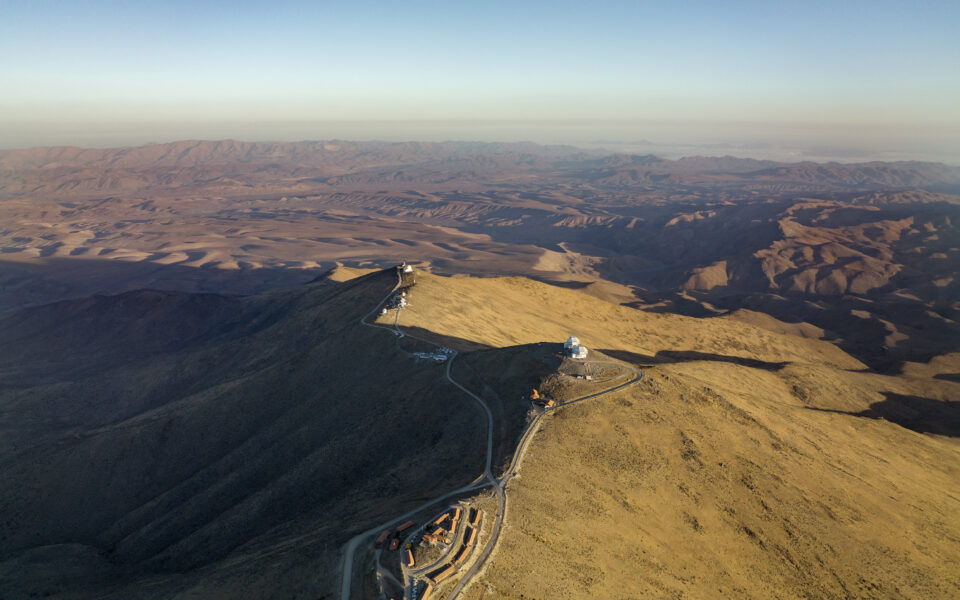Courting the sirens of the southern sky

To walk among the observatory domes of the Atacama Desert is to brush your hair with the stars.
The Atacama, on a plateau high in the Chilean Andes, is one of the driest and darkest places in the world. During the day one can see to Bolivia, far to the east, where clouds billow into thunderstorms that will never moisten this region. At night, calm, unruffled winds off the Pacific Ocean produce some of the most exquisite stargazing conditions on Earth.
One evening in late January the sky was so thick with stars that the bones of the constellations blurred into the background. The Milky Way, our home galaxy, was rolling straight overhead, and the Large and Small Magellanic Clouds, satellite galaxies of our own, floated alongside like ghosts. The Southern Cross, that icon of adventure and romance, loomed unmistakably above the southern horizon.
In the last half-century, astronomers from around the world have flocked to Chile and its silky skies, and now many of the largest telescopes on Earth have taken root along a sort of observatory alley that runs north-south for some 800 miles along the edge of the Atacama.
The residents include the Very Large Telescope, composed of four telescopes, each more than 8 meters (27 feet) in diameter, and built by an international collaboration called the European Southern Observatory. The Vera C. Rubin Observatory, another 8-meter telescope, is set to start operating next year, mapping the entire sky every three days.
(The ability of a telescope to harvest light from distant stars depends roughly on the area of its primary mirror. The Palomar Telescope in Southern California, an instrument that ruled astronomy into the 1990s, was 5 meters, or 200 inches, in diameter.)
Las Campanas Observatory, whose telescopes and offices are strung along a steep ridge on Cerro Las Campanas at an altitude of 8,500 feet, was one of the early adopters to the Atacama sky. Taking pride of place along the ridge today are two innovative telescopes, the Twin Magellans, each with curved sweeps of aluminized glass 6.5 meters in diameter, side by side in separate enclosures.
But these are just a beginning. Las Campanas is an outpost of the Carnegie Observatories, based in Pasadena, California, which in turn is owned by the Carnegie Institution for Science, based in Washington. The Carnegie Institution is a founder of and a driving force behind a consortium of 13 universities and institutions that aims to build the Giant Magellan Telescope, or GMT, a multibillion-dollar instrument more powerful than any existing ground-based telescope.
When completed, the telescope will have seven mirrors, each 8 meters in diameter, that together will act as a 22-meter-diameter telescope, roughly 20 times as powerful as Palomar. The GMT will be built at the top of Cerro Las Campanas, 2 miles from the domes of the Carnegie’s existing telescopes.
Equally gargantuan telescopes are being planned and built on mountaintops elsewhere around the world. With these cathedrals of glass, steel and technology, astronomers hope to capture their first detailed images of faraway planets, the next important step in the quest to determine whether the cosmos beyond Earth is habitable, or perhaps even inhabited.
Going South
The Carnegie Institution for Science was founded by Andrew Carnegie in 1902. It prides itself on its history in science and astronomy, said Eric D. Isaacs, a physicist and the institution’s president. In 1929, astronomer Edwin Hubble, using Carnegie telescopes on Mount Wilson, in Pasadena, discovered that the universe was expanding. In 1978, another Carnegie astronomer, Vera Rubin, confirmed that the stars and galaxies were swathed in clouds of a mysterious dark matter, which scientists still do not understand.
The Carnegie began eyeing Chilean skies in the 1960s as a potential site for a southern twin to the 200-inch Hale Telescope, which was completed on Palomar Mountain in 1948 in partnership with the California Institute of Technology. Twenty years later, the Carnegie bought 84 square miles in the Atacama region for 30 cents an acre. The National Science Foundation was establishing an outpost farther south at Cerro Tololo, and the European Southern Observatory, a European organization, had stationed telescopes on La Silla, a peak visible from Las Campanas.
“It was just a genius move,” Isaacs said. “This plot of land is wide open for ideas.”
The first telescope on Las Campanas, a 1-meter-wide reflector called the Swope Telescope, went into action in 1969. It was named after Henrietta H. Swope, an American astronomer and philanthropist who is credited with figuring out a way to measure the distances of stars and nearby galaxies.
In 1984, Bradford A. Smith of the University of Arizona and Richard J. Terrile of the NASA Jet Propulsion Laboratory used the Swope Telescope to discover a disk of dust around the star Beta Pictoris, evidence of planet formation in action. “That was the beginning of exoplanets,” said John Mulchaey, the director of Carnegie Observatories and its branch at Las Campanas.
And in 1987, when a star in the Large Magellanic Cloud exploded as a supernova, it was first seen by the Swope and, simultaneously, with the naked eye of a Las Campanas staff member who was on a break in the parking lot.
The Lure of the Southern Cross
The accommodations along astronomy’s Route 66 range from rustic to luxurious. Researchers at the Atacama Large Millimeter Array — at 15,900 feet, it’s the world’s highest radio telescope — must wear oxygen masks to visit; the Very Large Telescope has a swimming pool. All of the observatories have a soccer pitch and compete among themselves in a tournament every year. Consensus holds that the best food in all of astronomy is to be found at the Chilean observatories.
Getting to Las Campanas entails an overnight flight to Santiago (10 hours from New York or Los Angeles); a two-hour flight north to La Serena, a coastal resort town where some of the Chilean observatories, including Las Campanas, have offices; and then a three-hour drive up into the mountains.
Mulchaey lives in Pasadena, where Carnegie Observatories is based, but he commutes to Las Campanas regularly. His trip in January was his 134th since 1994, when he first came for postdoctoral research on the mass and fate of the universe. “At one point, I estimated that I’ve spent something like 15% of my adult life at LCO,” he said afterward in an email.
During the coronavirus pandemic, many of the observations at Las Campanas were carried out remotely. Neither Mulchaey nor Isaacs had been to the observatories since before COVID, and they were eager to get back.
“What has changed is the people,” Mulchaey said. Many of the staff members, who live down in La Serena, had retired. And too many astronomers had grown accustomed to observing from their living rooms, without the stress of the expensive and time-consuming trip to the telescope. As a result, the younger astronomers often didn’t know the telescopes or the people operating them.
“It’s important to get them back,” Mulchaey said.
Creatures of the Night
Next to the domes on Las Campanas is a cluster of cabins for visitors, staff members and researchers, who stay for a week at a time, and a lodge with a dining hall, which has a cappuccino machine.
Populating the ridge and surrounding slopes are herds of gazellelike creatures called guanacos; viscachas, marmotlike rodents with rabbity ears; burros; and hawks. The white domes of La Silla Observatory are visible to the south. Attached to the main lodge is a terrace where, at day’s end, astronomers gather to try to get a glimpse of the green flash, a rare last vestige of the sun as it disappears below the horizon, if the conditions are exactly right.
After sunset it’s lights out at the lodge, and observatory personnel will come and pull down the blinds on your cabin windows, if you haven’t done so already, to keep artificial light off the mountain and out of sensitive telescope instruments.
One night I walked over to the Swope Telescope, beneath a Milky Way so bright that it was possible to navigate the narrow trail by its light alone. Through the telescope I beheld banded Jupiter holding court with three of its glittering moons and, 160,000 light-years away in the Large Magellanic Cloud, mists of interstellar gas twining through the Tarantula Nebula.
The view at the top of Las Campanas the next morning was less immediately celestial: a cluster of construction trailers; a maze of rope barriers to keep visitors from falling off the mountain. Hawks circled a thin, metal tower that held various instruments to monitor the weather and the atmosphere.
Looking down, I teetered on the edge of a hole in the roof of the world. Concentric circular trenches, some as much as 60 feet deep, had been carved into the volcanic rock of the mountaintop, bringing to mind a pre-Columbian earthwork. This was the future home of the Giant Magellan Telescope. I asked Mulchaey what it would do that the James Webb and Hubble space telescopes could or would not.
“A lot,” he said.
For one thing, the Giant Magellan instruments were being prioritized for studying exoplanets, and would be capable of detecting rocky, Earthlike planets as far as 30 light-years away. Moreover, as technology improves over time, astronomers will be able to change and upgrade the main instruments, whereas space-based telescopes are stuck with whatever technology they carried at launch.
In a briefing down in one of the construction trailers, Oscar Contreras-Villarroel, the vice president of the Giant Magellan organization and its legal representative to the Chilean government, elaborated on the GMT’s capabilities. The design includes a sophisticated adaptive-optics system to compensate for atmospheric turbulence that can blur celestial details (and make stars twinkle). And some of the mirrors will be able to adjust their shape 2,000 times a second, to keep star images crisp over a field of view two-thirds the size of a full moon. (The Webb telescope’s field of view is only one-tenth of a full moon.)
“It will be able to resolve the torch on a dime at 99 miles,” Contreras-Villarroel said.
The first of the Giant Magellan mirrors was cast in 2005 beneath the University of Arizona’s football stadium, in a rotating furnace developed by J. Roger P. Angel, an Arizona astronomer, as a way to build giant mirrors. Three of the mirrors are now completed and sit in boxes at the Tucson airport. Three more are being polished and tested. The seventh and final mirror is set to be cast this year.
Depending on funding, the telescope could begin operations in 2030, Isaacs said in an email. “As soon as we have four mirrors, we will start collecting photons,” he wrote. “This is first light. We will be able to start early science. Construction is complete with seven mirrors and we go into regular operations.”
The peak of Las Campanas was blasted flat in 2012 to make room for the telescope, which will be almost as big as a football stadium and more than 22 stories high.
Miguel Roth, a former director of Las Campanas, led an up-close tour of the foundation. It had taken nine months to excavate, at times by hand, he said, to avoid using explosives that might fracture the underlying rock. Giant ball bearings will insulate the telescope from earthquakes. The telescope building, a giant rotating cylinder, has been designed with a system of vents and windscreens to keep the temperature inside constant. Moreover, all heat-producing machinery will be underground and downstream from the prevailing wind, thwarting thermal air currents that could affect the sensitive mirrors.
“The telescope is to be one with the mountain,” Roth said. “We’ve got one of the best sites in the world, if we don’t screw it up.”
Cosmic Company
Two decades ago, the Giant Magellan was one of three efforts hatched by competing groups of astronomers and institutions to create a new generation of Brobdingnagian telescopes unparalleled in the ability to gather starlight and pierce the voids of the night sky.
In Hawaii, a U.S.-led collaboration is trying to build the Thirty Meter Telescope atop Mauna Kea but has encountered opposition from native Hawaiian activists. And farther north in the Atacama, the European Southern Observatory is set to build the European Extremely Large Telescope by the end of the decade. It will be the biggest of three, with a composite mirror 39 meters across.
Neither the Giant Magellan nor the Thirty Meter Telescope has yet raised enough money — $2.54 billion and $3.7 billion — to fulfill its celestial dreams. Completion will depend on the generosity of the National Science Foundation, which traditionally supports ground-based astronomy in the United States, and ultimately Congress.
Robert N. Shelton, president of the Giant Magellan Telescope Organization, said he was confident that its day would come. “When complete, the Giant Magellan Telescope will be one of the largest public-private funded science projects in history,” he said. “Any delay in resources will extend the time to complete our project, but we remain committed to the success of the telescope.”
As I stared down into the rocky eye on top of Las Campanas, I tried to imagine what the Giant Magellan and its brethren would reveal about our mysterious cosmos, and which lucky astronomers would reap the knowledge.
“Not us,” Mulchaey said.
Nowadays it takes a generation to build a scientific instrument as majestic as a telescope or a new particle collider. Already the keys to the cosmos are passing into the hands of astronomers who may not have been born when the Giant Magellan was conceived. But dreams are what the cosmos is made of.
This article originally appeared in The New York Times.






